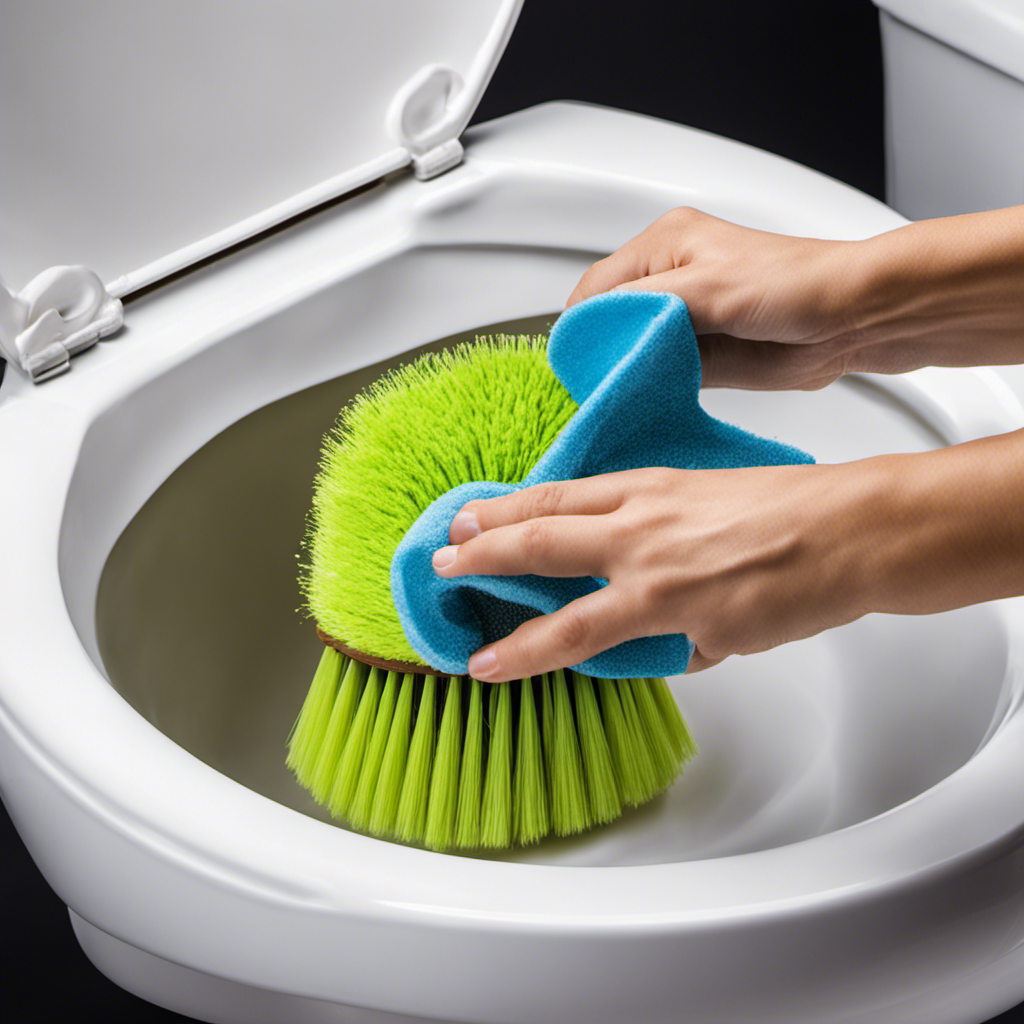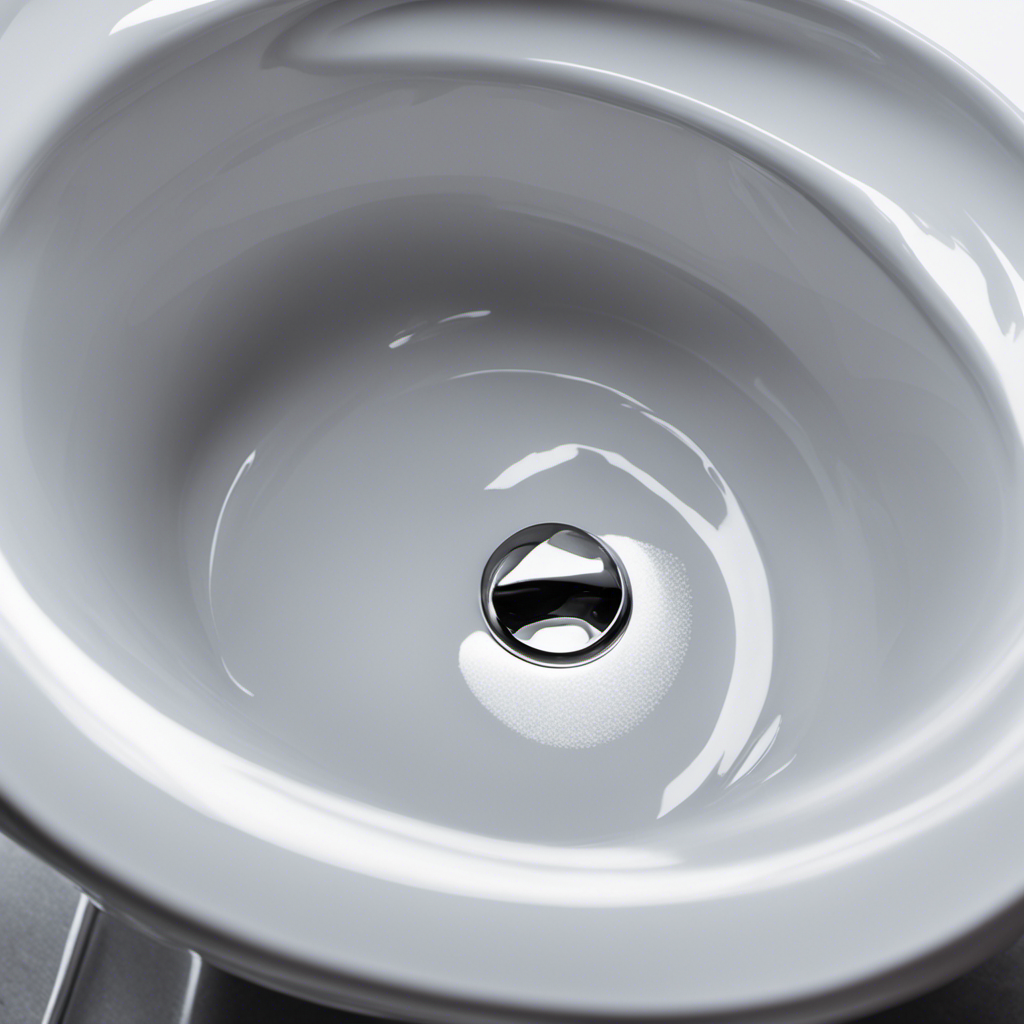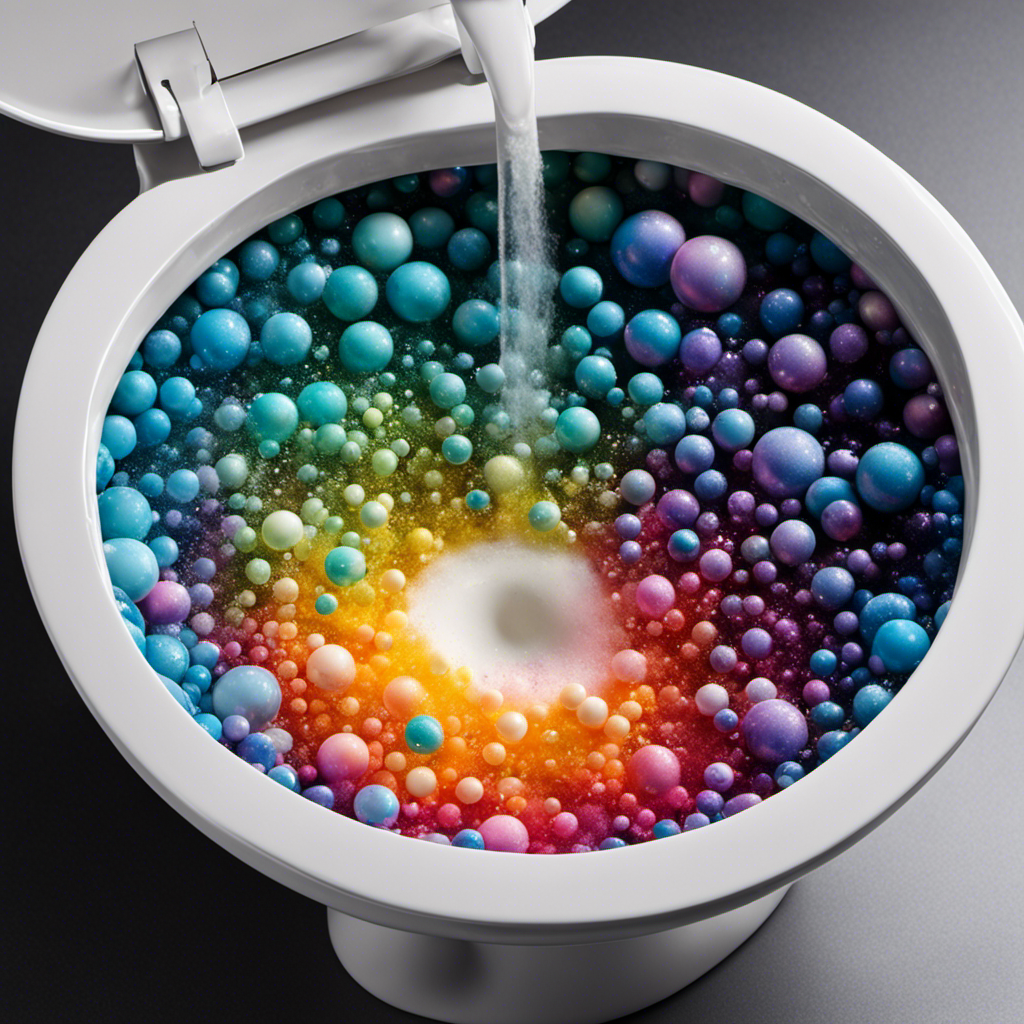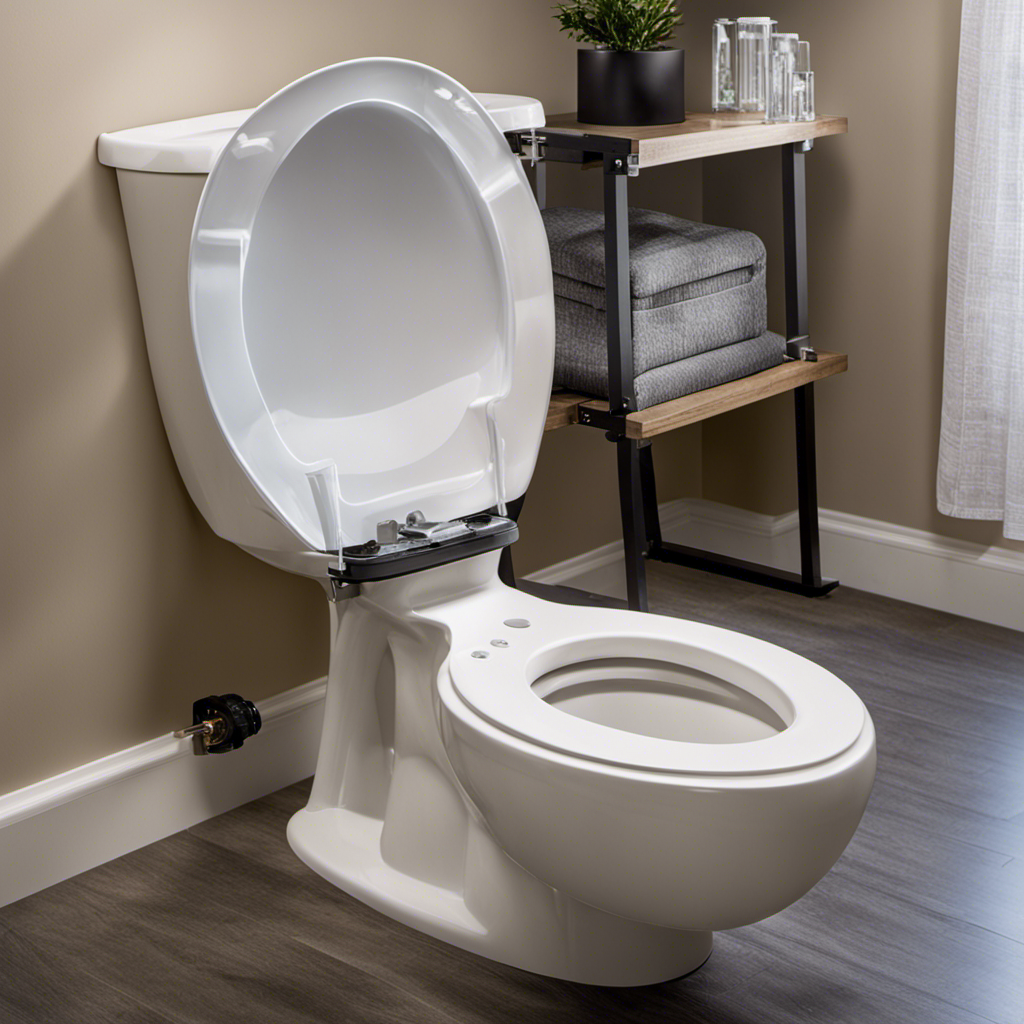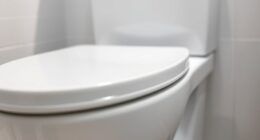They say a clean toilet is a happy toilet. And I couldn’t agree more. There’s nothing worse than a stubborn ring staining the pristine surface of your porcelain throne.
But fear not, because I’m here to share my expert knowledge on how to banish those unsightly toilet rings for good. With a few simple steps and some effective cleaning methods, you’ll have a ring-free toilet that will leave you feeling accomplished and your bathroom sparkling clean.
So let’s roll up our sleeves and get to work!
Key Takeaways
- Toilet rings are caused by mineral deposits, hard water stains, and bacteria buildup.
- Regular cleaning with a toilet brush and mild cleaning solution helps prevent toilet rings.
- Using a vinegar and baking soda mixture or lemon juice can help prevent ring formation.
- Regular maintenance of water level in the toilet tank and using a toilet bowl cleaner with citric acid can prevent rings.
Understanding the Causes of Toilet Rings
To understand why you have a toilet ring, you should know the common causes. Toilet rings are generally caused by a combination of mineral deposits, hard water stains, and bacteria buildup.
When water containing minerals like calcium and magnesium evaporates, it leaves behind a residue that can form a ring in the toilet bowl. Hard water stains occur when minerals in the water react with soap scum and other substances in the toilet.
Bacteria can also contribute to the formation of toilet rings if not cleaned regularly. To prevent toilet rings, it is important to regularly clean the toilet using a toilet brush and a mild cleaning solution. Additionally, using a toilet bowl cleaner specifically designed to remove mineral deposits can help prevent the formation of toilet rings.
Gathering the Necessary Cleaning Supplies
You’ll need a few cleaning supplies to get started on tackling that stubborn stain.
When it comes to toilet cleaning, there are a few essential items you’ll want to have on hand.
Firstly, a pair of rubber gloves is crucial to protect your hands from any harsh chemicals.
Next, grab a toilet brush with stiff bristles to effectively scrub away the ring.
For DIY cleaning solutions, consider using a mixture of baking soda and vinegar. These two ingredients work wonders when it comes to removing stains and eliminating odors.
Additionally, a bottle of bleach or a toilet bowl cleaner can be used for extra cleaning power.
With these supplies in tow, you’ll be well-equipped to tackle that pesky toilet ring.
Preparing the Toilet for Cleaning
Removing stubborn stains effectively and using appropriate cleaning solutions are essential steps in achieving a spotless and hygienic toilet.
When it comes to tackling tough stains, it is crucial to have the right techniques and products at hand.
In this discussion, I will share my expertise on how to effectively remove stubborn stains and choose the most suitable cleaning solutions for your toilet, ensuring a pristine and germ-free environment.
Removing Stubborn Stains Effectively
For a highly effective way to tackle stubborn stains in your toilet ring, start by using a powerful toilet bowl cleaner.
Here are four techniques that I’ve found to be effective in removing these stubborn stains:
-
Scrub with a toilet brush: Apply the cleaner to the affected area and scrub vigorously with a toilet brush. This will help break down the stains and remove them from the surface.
-
Use a pumice stone: Wet the pumice stone and gently scrub the stains. Make sure to keep the surface wet to avoid scratching the porcelain.
-
Try a vinegar and baking soda solution: Mix equal parts vinegar and baking soda to form a paste. Apply the paste to the stains and let it sit for a few hours. Scrub with a brush and rinse thoroughly.
-
Use a natural toilet bowl cleaner: Look for cleaners that are made with natural ingredients like lemon, essential oils, or plant-based enzymes. These cleaners are effective in removing stains while being environmentally friendly.
Using Appropriate Cleaning Solutions
Mixing vinegar and baking soda creates a powerful cleaning solution that is effective in tackling stubborn stains in your bathroom. When it comes to cleaning your toilet bowl, using the right cleaner is crucial.
Many commercial toilet bowl cleaners contain harsh chemicals that can be harmful to your health and the environment. That’s why I always opt for natural cleaning alternatives like vinegar and baking soda.
Vinegar is known for its acidic properties, which help break down tough stains and kill bacteria. Baking soda, on the other hand, acts as a gentle abrasive that scrubs away dirt and grime. Together, these two ingredients make a potent and safe toilet bowl cleaner.
Simply pour half a cup of vinegar into the bowl, let it sit for a few minutes, then sprinkle baking soda and scrub with a toilet brush. Rinse thoroughly, and voila! Your toilet bowl will be sparkling clean without any harsh chemicals.
Applying Effective Cleaning Methods
When it comes to effectively cleaning a toilet, there are several methods that can get the job done.
One option is to use fizzing toilet bombs, which combine baking soda, citric acid, and essential oils to create a powerful cleaning agent.
Another method involves using a mixture of vinegar and baking soda, which creates a chemical reaction that helps break down stains and eliminate odors.
Lastly, the pumice stone technique can be used to physically scrub away stubborn stains and mineral deposits.
Each of these methods has its own unique benefits and can be used depending on the specific cleaning needs of your toilet.
Fizzing Toilet Bombs
To clean the ring in your toilet, you can easily make fizzing toilet bombs. These DIY cleaning solutions are not only effective in removing stubborn stains and mineral deposits, but they are also a natural alternative to harsh chemical cleaners.
Here are four reasons why fizzing toilet bombs are a great option for toilet ring prevention:
-
Effervescence: When dropped into the toilet bowl, the fizzing action helps break down and lift away dirt and grime.
-
Baking soda: This natural ingredient acts as a gentle abrasive, scrubbing away stains without scratching the toilet surface.
-
Citric acid: Known for its powerful cleaning properties, citric acid helps dissolve mineral deposits and stubborn rings.
-
Essential oils: Adding a few drops of essential oils, such as tea tree or lemon, not only leaves your toilet smelling fresh, but also adds antimicrobial properties.
Transitioning into the subsequent section about vinegar and baking soda, let’s explore another effective method for cleaning toilet rings.
Vinegar and Baking Soda
Using vinegar and baking soda together creates a powerful cleaning solution that can effectively tackle tough stains and mineral deposits in your toilet. These natural cleaning alternatives are not only effective, but also safe for the environment and your health. Vinegar, with its acidic properties, helps dissolve stains and remove odors, while baking soda acts as a gentle abrasive to scrub away grime. When combined, they create a fizzing reaction that helps lift and loosen dirt and debris. To use this method, simply pour a cup of vinegar into the toilet bowl, followed by half a cup of baking soda. Let it sit for a few minutes, then scrub with a toilet brush and flush. For extra cleaning power, you can also add a few drops of lemon juice to the mixture.
Here is a table summarizing the benefits of using vinegar and baking soda as natural cleaning alternatives:
| Benefits | Vinegar | Baking Soda |
|---|---|---|
| Effectiveness | Dissolves stains and removes odors | Acts as a gentle abrasive |
| Safety | Environmentally friendly and non-toxic | Non-toxic and safe for your health |
| Versatility | Can be used for various cleaning tasks | Can be used for scrubbing and deodorizing |
| Cost | Affordable and easily accessible | Inexpensive and readily available |
Pumice Stone Technique
The pumice stone technique is an effective way to remove stubborn stains and mineral deposits from your toilet bowl. I have personally used this method and found it to be incredibly useful.
Here are four reasons why the pumice stone technique is worth trying:
-
It is gentle yet powerful: The pumice stone gently scrubs away stains and mineral deposits without damaging the porcelain surface of the toilet bowl.
-
It is versatile: The pumice stone can be used on various surfaces, including ceramic, porcelain, and even glass, making it a versatile cleaning tool.
-
It is cost-effective: Pumice stones are affordable and can be reused multiple times, making them a cost-effective option for cleaning your toilet bowl.
-
It is easy to use: Simply wet the pumice stone and gently rub it on the stained areas of the toilet bowl. The stains will easily come off, leaving your toilet bowl looking clean and fresh.
While the pumice stone technique is effective, there are alternatives to consider, such as using vinegar and baking soda, to prevent ring formation in toilets.
Removing Stubborn Stains and Discoloration
If you’ve tried scrubbing but the ring in your toilet just won’t budge, it might be time to consider using a stronger cleaning solution.
When it comes to removing stubborn stains and discoloration, there are a few options that can help. One effective method is to use a mixture of vinegar and baking soda. Simply pour a cup of vinegar into the toilet bowl and let it sit for a few minutes. Then, add a cup of baking soda and let the mixture fizz for a bit. After that, scrub the bowl with a toilet brush and flush.
Another eco-friendly option is using hydrogen peroxide. Apply it to the ring and let it sit for a few minutes before scrubbing. Remember to always wear gloves and ensure proper ventilation when using these cleaning solutions.
Now, let’s move on to maintaining a ring-free toilet.
Maintaining a Ring-Free Toilet
To keep your toilet bowl looking clean and free of discoloration, it’s important to regularly maintain it. Here are four tips to prevent future ring formation and keep your toilet sparkling:
-
Regular cleaning: Make it a habit to clean your toilet bowl at least once a week using a toilet brush and a natural DIY cleaner. This will help remove any buildup and prevent the formation of stubborn rings.
-
Vinegar and baking soda: Mix equal parts of vinegar and baking soda to create a powerful cleaning solution. Apply it to the toilet bowl, let it sit for a few minutes, then scrub and flush. This natural combination helps dissolve stains and prevent ring formation.
-
Lemon juice: Squeeze fresh lemon juice into the toilet bowl and let it sit for a while before scrubbing and flushing. The acidic properties of lemon juice can help remove stains and prevent future rings.
-
Regular maintenance: Check the water level in your toilet tank regularly and adjust it if necessary. A low water level can cause mineral deposits to build up and contribute to ring formation. Additionally, consider using a toilet bowl cleaner that contains citric acid to help prevent rings from forming.
Frequently Asked Questions
Can I Use Bleach to Clean a Ring in the Toilet?
Yes, bleach can be an effective option to clean a ring in the toilet. However, there are also bleach alternatives that can provide similar results. I will provide more precise and detailed information on effective toilet cleaning methods.
How Often Should I Clean the Toilet to Prevent Ring Formation?
To prevent toilet ring formation, I find that the saying "An ounce of prevention is worth a pound of cure" holds true. Regular cleaning with the best products removes stains and keeps the toilet ring-free.
Are There Any Natural Alternatives to Chemical Cleaners for Removing Toilet Rings?
There are natural alternatives to chemical cleaners for removing toilet rings. Homemade remedies like vinegar, baking soda, and lemon juice can be effective in breaking down the buildup and leaving your toilet clean and fresh.
Is It Safe to Use a Pumice Stone to Scrub the Toilet Bowl?
Using a pumice stone to clean toilet bowls has pros and cons. It’s effective at removing stubborn stains, but it can also scratch the surface. There are alternative methods for removing toilet bowl rings.
What Are Some Common Mistakes to Avoid When Cleaning a Toilet Ring?
When cleaning a toilet ring, it’s important to avoid using abrasive cleaners and not letting the cleaner sit for long enough. These common mistakes can damage the toilet bowl and make cleaning more difficult.
Conclusion
In conclusion, cleaning a ring in the toilet may seem like a daunting task, but it can be easily accomplished with the right knowledge and supplies.
Anticipating objections, some may argue that regular cleaning should prevent toilet rings altogether. While this is true to some extent, factors such as hard water and mineral deposits can still lead to ring formation.
By following the effective cleaning methods outlined in this article and maintaining regular cleaning habits, you can ensure a clean and ring-free toilet for years to come.
